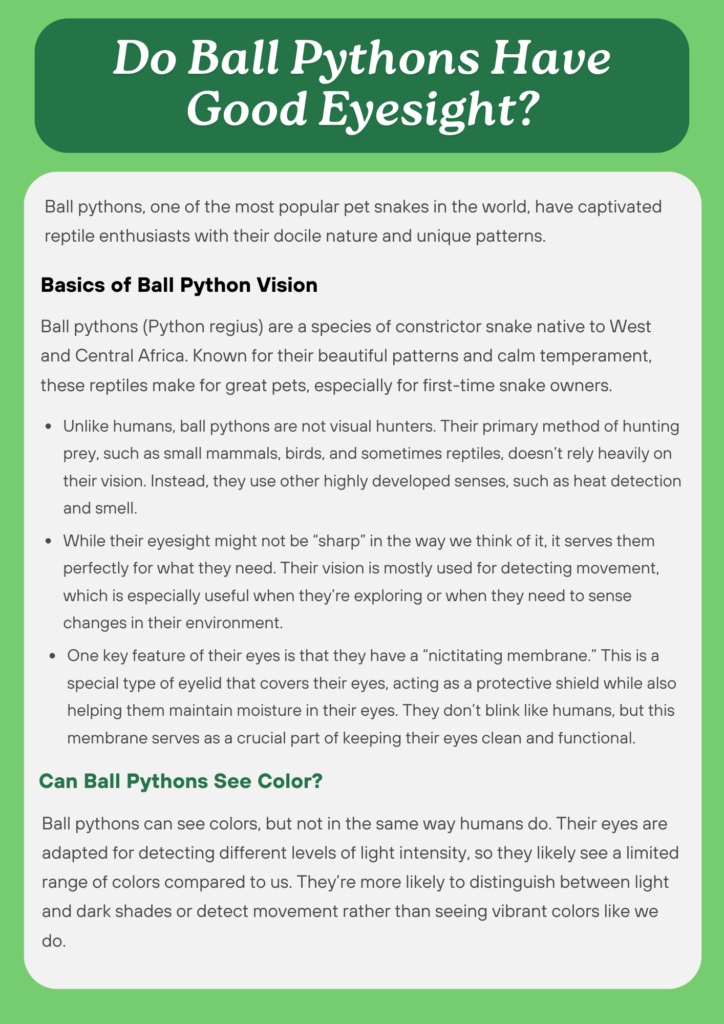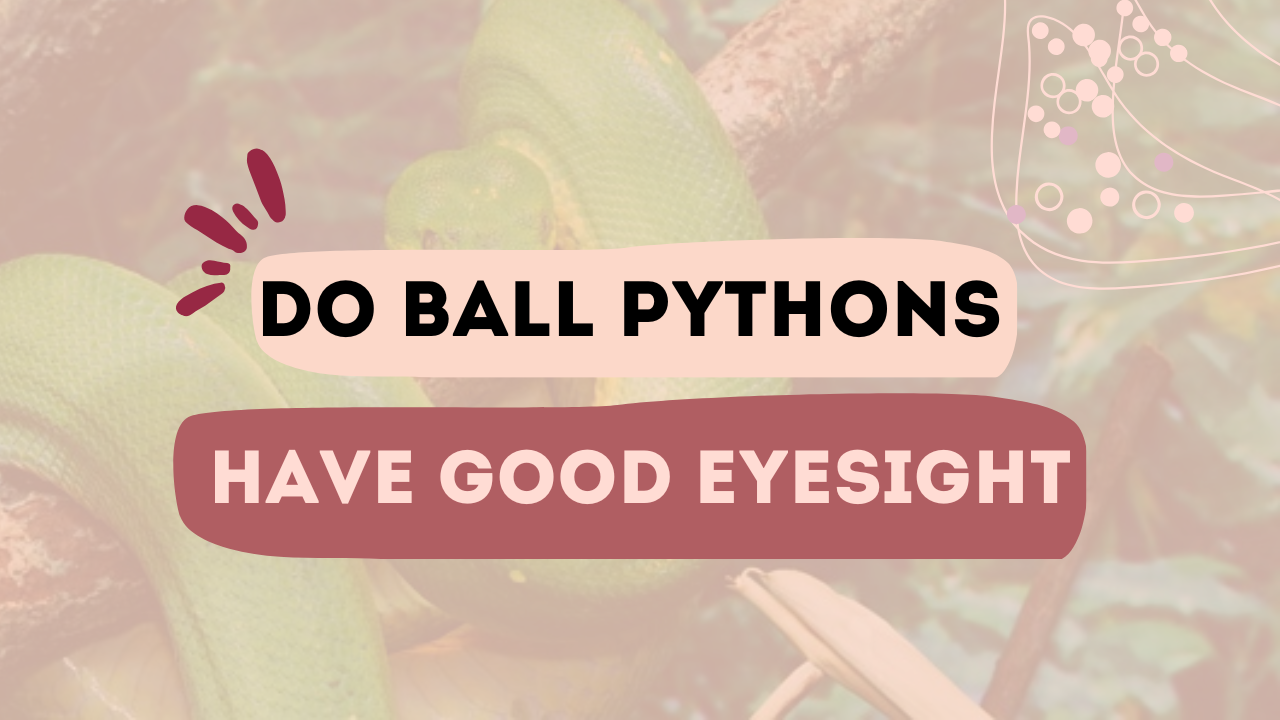Ball pythons, one of the most popular pet snakes in the world, have captivated reptile enthusiasts with their docile nature and unique patterns. But if you’re a proud owner or just an enthusiast wondering, “Do ball pythons have good eyesight?” you’re not alone. The truth is, their vision is quite different from that of humans, and understanding it can be fascinating. In this article, we’ll dive deep into what we know about their eyesight, how they rely on other senses, and what that means for them as both predators and pets. Get ready for an interesting ride through the world of ball pythons, because their eyes—and the way they work—are a lot more complex than you might think!
Understanding the Basics of Ball Python Vision
Ball pythons (Python regius) are a species of constrictor snake native to West and Central Africa. Known for their beautiful patterns and calm temperament, these reptiles make for great pets, especially for first-time snake owners. But when it comes to their eyesight, there are some important things to understand.
Unlike humans, ball pythons are not visual hunters. Their primary method of hunting prey, such as small mammals, birds, and sometimes reptiles, doesn’t rely heavily on their vision. Instead, they use other highly developed senses, such as heat detection and smell. Their eyes are adapted more for survival in a different way than humans or many other predators.
So, do ball pythons have good eyesight? Well, it’s all relative! While their eyesight might not be “sharp” in the way we think of it, it serves them perfectly for what they need. Their vision is mostly used for detecting movement, which is especially useful when they’re exploring or when they need to sense changes in their environment.
What’s Special About Their Eyes?
Let’s get into the nitty-gritty details of their vision. Ball pythons, like all snakes, have a unique visual system that is adapted to their lifestyle. They possess both rod and cone cells in their eyes, which allows them to detect light and movement, although they can’t see fine details like humans can. This means that while they might not see color the same way we do, they can still detect basic shapes, movement, and changes in light intensity.
One key feature of their eyes is that they have a “nictitating membrane.” This is a special type of eyelid that covers their eyes, acting as a protective shield while also helping them maintain moisture in their eyes. They don’t blink like humans, but this membrane serves as a crucial part of keeping their eyes clean and functional. Imagine a windshield wiper for your eyes, but only when you need it!

Ball Python Vision vs. Human Vision
If you’re thinking about how a ball python’s eyesight compares to your own, it’s important to know that there are significant differences. Humans, for example, are visually oriented creatures with sharp eyesight, enabling us to distinguish a wide range of colors, shapes, and fine details. Ball pythons, however, don’t need such sharp vision because they rely on different senses to navigate their world.
Ball pythons rely much more on heat-sensing abilities to locate their prey. They have specialized pits on their faces, called “labial pits,” that allow them to detect infrared radiation (heat). This is a crucial adaptation for detecting the body heat of warm-blooded animals in their environment, making them excellent at finding prey even when it’s hidden or in low-light conditions.
Do Ball Pythons Rely on Sight for Hunting?
The short answer is no, not really. Ball pythons do not primarily use their eyes to hunt. In fact, their vision plays a relatively minor role compared to other senses. As mentioned earlier, they are equipped with those specialized heat-sensing pits, which are incredibly effective in low-light conditions. This means they can “see” the heat of their prey even in complete darkness, making their ability to hunt so efficient.
Instead of focusing on fine details or visual cues, a ball python uses its infrared vision to detect heat signatures and movement. This is why they can strike with such precision, even in total darkness. Their eyes serve more as a secondary tool for situational awareness, like noticing changes in light or movement, rather than providing them with clear visual images of their environment.
How Does a Ball Python Navigate Its Environment?
Now, while sight might not be their main tool for hunting, it’s still an important part of how they explore their world. Ball pythons rely on a combination of their sense of smell (through their forked tongues) and their ability to sense vibrations in the ground to help them navigate their environment. They’re not blind by any means—they just don’t rely on their eyes for the same things we do.
When a ball python is moving through the grass or on the forest floor, it picks up environmental scents through its tongue, which it uses to navigate. They also have an acute sense of vibration, which is why they can detect subtle movements around them, even without seeing them. This multi-sensory approach to exploration ensures they don’t miss anything important in their environment, even if their eyesight isn’t perfect.
Can Ball Pythons See Color?
Great question! Ball pythons can see colors, but not in the same way humans do. Their eyes are adapted for detecting different levels of light intensity, so they likely see a limited range of colors compared to us. They’re more likely to distinguish between light and dark shades or detect movement rather than seeing vibrant colors like we do.
Snakes, in general, have what’s known as dichromatic vision. This means they can perceive two primary color ranges, which helps them to detect subtle differences in their environment. However, they don’t have the full spectrum of color vision that humans do. So, while ball pythons might see shades of light and dark, they don’t get the rainbow effect that we’re used to!
Do Ball Pythons Have Bad Eyesight?
You might be thinking, “Wait, so if they don’t see as well as we do, does that mean they have bad eyesight?” Not necessarily. Ball pythons have vision that works perfectly for their needs. While they might not have the sharp eyesight of a hawk or a cat, their eyes are adapted to detect movement, light, and dark, which is exactly what they need for survival. Their infrared detection system and other senses fill in the gaps, ensuring they can hunt, explore, and protect themselves effectively.
Final Thoughts on Ball Python Eyesight
So, in conclusion, ball pythons don’t have the best eyesight compared to humans or some other animals. But they have evolved to rely on other senses, such as heat detection and smell, to navigate their world. Their eyes are specialized for detecting movement and changes in light, which is enough for their needs as ambush predators. So, while their eyesight might not win any awards for sharpness or color recognition, it’s perfectly suited for their survival in the wild!
If you’re a ball python owner, it’s important to remember that your snake’s vision isn’t its primary sense. Understanding how they use their other senses will help you create a more enriching environment for them. Whether it’s providing places to hide, offering a range of textures to explore, or giving them prey they can detect using their heat-sensing abilities, your snake will be happy and healthy.

